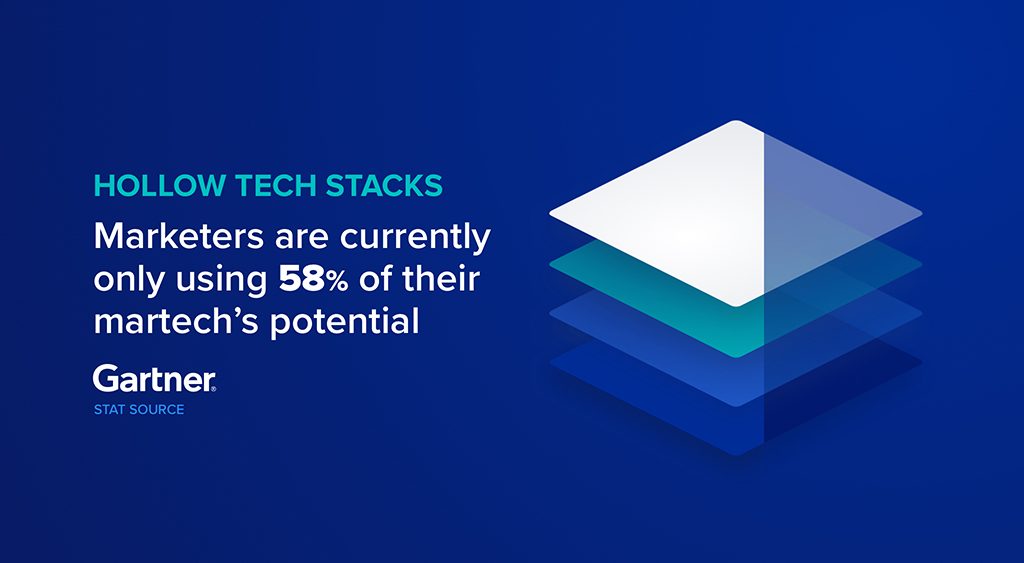From simple to complex, B2B marketing barriers come in many forms. But we have some actionable insights on how you can break through these barriers and pivot your team towards a result-oriented future.
B2B marketing executives often lament the challenges of working in a business-to-business model, maintaining that many traditional practices are dry and unengaging. The inherent sentiment that storytelling and creativity are only reserved for B2C content, is far from the truth. Since automation took over the B2B marketplace, it underwent a huge shift from bricks and mortar to e-commerce, where consumer-centric marketing became the key for B2B success. It relied heavily on cultivating an online presence and ranking higher on search engines, paving the way for clever and original content that appealed to the B2B buyer sentiments.
Though automation plugged much of the marketing and sales gap, B2B leaders faced a unique set of challenges that came with going digital. These were precisely because of the wide breadth of capabilities in automated processes that can cause problems in terms of integration, strategy, alignment and overall scope. This blog addresses the common barriers faced by a B2B marketing brand and the next best actions to overcome them.
Barrier #1: Standing Out Online
Most people count on the internet to provide them with the information they need- whether it’s the recipe to a mean meatloaf or, more importantly, which service or product best serves their business needs. This makes it critical for B2B marketers to have a strong online presence. But with more than a billion websites to choose from, it can become difficult to stand out online and draw the right visitors to your site.
Steer clear of these digital eyesores:
- A sharp-looking website with hundreds of technical issues in the backend that are ruining its visibility in search results
- A poor social media presence only restricted to posts about the company and links to new blogs, or taking months to message someone back and ignoring comments
- A wonderful evergreen piece of content that has not been leveraged properly to improve the brand’s digital presence
- Not providing the information your customers are looking for with uncategorised content on your website, ruining the user-experience
- A website that has an increased load time and is not optimised for mobile phones
Action to take:
Create high-quality landing pages and make your website mobile-friendly. Develop an SEO strategy that not only optimises the website and improves your ranking on search engines, but also provides long-term incremental improvements that can positively boost your lead generation.
Create actionable content that is story-driven, peppered with the right keywords, and utilizes an appropriate branding strategy. Strategic content marketing nurtures customer relationships, giving them a reason to revisit your website or sign-up for newsletters. So, remember to build a compelling one, using different content forms on multiple channels for different stages of the buyer journey.
Barrier #2: Cutting Corners on MarTech Budgets
Some businesses are too afraid to foot the bill on expensive marketing tech stacks. Instead, they continue to rely on traditional practices without fully leveraging the power of marketing technologies. This will never get you the desired results. No matter how fantastic your B2B team is or how incredible their ideas are, a hollow tech stack breeds low-quality work. As a result, your marketing efforts will fall flat and remain purely at the surface level unless you fill the gap.



Action to take:
Stop penny-pinching on marketing technologies. The right tools will not only help you take on incumbent industry giants but also accelerate your daily B2B activities.
Some essential martech categories are-
- Content Creation Tools
- Content Management Tools
- Marketing Automation Systems
- Account-based Marketing Systems
- Lead Scoring and Management Tools
- Data Management Tools
- Reporting Tools
Granted these softwares have a complex ecosystem, but there are plenty of ways to learn how to best use them- just like you would with any other skill. Having someone onboard your team can also help manage them. They will know which tools to choose from in a frighteningly wide range of solutions and properly connect them to the right channels. In the longer run, it is so much more cost-efficient than coding your own internal systems.
Barrier #3: Repetitive, Dull and Snooze-worthy Marketing Campaigns
Putting together a winning campaign is always a challenge for marketers. But B2B brands have a reputational tendency for being too formal and jargonistic. The result is a cut-and-dried B2B campaign that fails to generate excitement or engage with targeted prospects. While some industries may certainly lend themselves to a more clinical approach (like healthcare or legal services), it’s important to remember that you are still speaking to flesh-and-blood prospects.
A common struggle for B2B marketers is to create snackable content for their campaigns. It’s a sad state of affairs when useful insights, often buried in layers of lengthy and text-heavy whitepapers or case studies, are slept on. Considering that almost half of all B2B researchers and buyers are now from the millennial generation, there are different expectations while interacting with these digital natives. One of the biggest mistakes a B2B marketer can make is talking to them like they are business entities.



Action to take:
The first thing would be to dispel the misconception that you have to talk to a B2B audience differently. Remember that they are still human beings with personalities even when working in a B2B environment. No matter how technical or niche your product may be, you need to humanize your brand and put customers at the front end of your marketing campaigns. Social media strategies that revolve around customer engagement, can immediately make your brand feel more personable. You can also flex your industry influence on social platforms and use it to educate prospects.
Don’t underestimate the power of storytelling. Keywords and searcher intent are just as important as guiding visitors down the sales funnel through the use of interesting, easy-to-consume and insightful content that triggers an emotional impact. In the age of flatscreens and virtual realities, there’s a reason campfire tales continue to remain a favourite pastime- humans are hardwired to appreciate a good yarn.
It’s easy to overlook the importance of presentation in B2B marketing services. Get rid of those heavy walls of text for easy-to-scan-at-a-glance web pages featuring rich media assets like- custom images, illustrations, videos and social media embeds. If you’re positive that your audience may require a more staid approach to gain their confidence, then create content in a more highbrow tone. But whatever you do, don’t just settle for the tried-and-tested. Instead, learn to take calculated risks. Think of what makes you different from your competitors and how can you make it apparent without being too bland or over-the-top.
Barrier #4: Being Overly Self-Promotional in your Content
Tasteful promotion is good for your brand. Known as personal branding, it can raise awareness for your product or service in the minds of prospects. It can even add a nice touch to your messaging. Only as long as it’s clever and seamless, without indulging in too much, obvious self-praise. But what happens when B2B branding starts to hinge on too much self-promotion?



It hurts your brand. When you go overboard with your promotional tactics, it begins to have the opposite effect of what was intended. No one likes a brag-it-all and it is a massive turn off for consumers. A study by Bizadmark shows that 79% of the content marketers believe that content written for business purposes comes from a place of too much self-promotion. Another alarming statistic from Contently reported that businesses are likely to experience a nearly 50% drop in customer trust for indulging too much in self-promotional activities.
Action to take:
Authenticity matters. Rather than signing off an otherwise objective blog post or newsletter with a service promotion or product pitch, consider being informative and double-checking your content for misrepresented facts. Clients intending to make a purchase will always investigate a brand’s truth from other sources. If they can’t corroborate the content with non-company sources, they will lose trust in your brand.
Even if you are doling out branded content, resist the urge to be too self-promotional. Avoid repetition or lofty praises about your achievements that are too direct. Make it engaging and insightful, with verification from named sources. This will improve your content’s credibility and foster a loyal consumer base, adding to your brand’s equity.
Barrier #5: Using Unfamiliar Jargons in Messaging
No other industry is guilty of overdoing jargon as much as B2B. While every trade has their niche language, B2B marketing is pregnant with specific buzzwords that can turn good content into boilerplate jargon that doesn’t reflect the way consumers actually speak. While some level of jargon is unavoidable, it shouldn’t replace simpler industry-specific terms that can accurately describe your company’s product or services.
Many B2B firms find themselves showing up for certain keywords and misunderstand it for doing well in their search engine rankings. Of course, they rank up well for it because nobody else is using them. It does not align with your customer language, and it might as well have been a term coined by their marketing team.



For instance, buyers who search for rocking chairs are either using “rocking chairs” or a long-tail keyword like “best cherry wood rocking chair for back pain”. They are not searching for “WoodBest™ ultra swing defining curved sitting machines.” Nobody knows (or cares) what a “curved sitting machine is”. Maybe they will once they get to your page, watch your video, download your PDF, gain awareness, etc. – but you need to get them there first. But that is unlikely to happen without a properly executed paid search, organic search and earned media.
Action to take:
The first and foremost step is to speak your customer’s language. Be aware of not only using jargon but also understanding when the jargon you use internally isn’t the same as the jargon your customers are using. It’s easy for companies to get lost in a jargon-rich bubble, constantly recycling industry buzzwords without a fair understanding of how their customers describe the product or service they offer. A key part of showing up on search results is using the correct terminology that visitors search for on your page.
If you are a traditional B2B marketing agency with a website that has been online for many years, your keywords may have lost their relevance today. Revisit your keywords and update them to align with today’s search queries. Rely on Google’s free keywords search tool, to know which terms used by your brand have a dense search volume.
Barrier #6: Giving Competitors and Distributors Your Web Traffic
There are numerous third-party distributors out there that have already taken the lead in the B2B online space. Infact, they are outranking actual business-to-business brands (meaning you and your competitor’s brand) in the search results. They are paying for text and shopping adverts on Google and Bing before visitors can even get to see your organically ranking pages. A good case in point is the following example from the industrial lubrication space:



These types of sites, in addition to traditional online marketing, have e-commerce capabilities as well, enabling visitors to buy products similar to yours from them online. In such a case, buyers aren’t required to submit an excruciatingly long form or call someone for every single product. For B2B products and services, there are now statistics showing digital as the most important sales channel for millennials. Companies like Amazon, are quick to pick up on that and have already started delving into the B2B space for eventually selling their products or services exactly like yours.
Action to take:
To remain competitive, B2B marketers should meet consumers where they shop by developing sustainable online marketplace strategies. You can establish management roles that handle your day-to-day business operations online, like an e-commerce marketplace manager or a third-party content manager. Having these marketplace-specific merchants along with traditional account management structures is the way to winning the B2B digital space.
Barrier #7: Keeping Up with The Changing Buyer Journey
Historically, when looking for a product or service, people would open up the Yellow Pages, speak to their colleagues or call the sales agent who had popped in and dropped off their card at the doorstep. Now, 70-90% of the B2B buying process is completed before the sales team can even reach out to the buyers. What was once a linear process, is now a convoluted one with infinite touchpoints. Earlier, sellers used to knock on the buyer’s door, but it’s the other way round now. Your B2B team could have the perfect solution to their problem, but they would never know about it without your content reaching them.



The emphasis on inbound marketing has transformed the way today’s tech-savvy buyers approach, engage and consume content, before making an informed purchase decision. There are so many stakeholders involved now, each armed with their own research and opinion, that keeps changing with every transaction, making it extremely difficult for B2B firms to win their business.
Action to take:
A complex and dynamic buyer journey with multiple stakeholders can get too overwhelming for B2B sellers. There is no way of knowing every possible interaction that could potentially occur beforehand. So, in this case, to earn their business, you must proactively work to simplify the steps of their journey and then create experiences that will meet their needs. Remember that, customer journey is made up of moments. So, the foremost thing to do is educate yourself on the buyer’s businesses, the complexities of their buying environment and then address the pain points you are trying to solve with your product or service.
Having an omni-channel marketing strategy and delivering different content for each buying stage can help create those moments, minimise unnecessary interactions and ease the selling process. For this, you can break down your interaction with buyers into three stages- delight, engage and attract. This will help you focus on specific tactics that will resonate the most with high-fit buyers, ensuring a seamless consumer experience.
The B2B landscape is transforming everyday and it’s no longer simple to convince prospects to work with you. Sometimes, when a problem is solved, it opens the door to another one. No matter how strong and integrated your marketing solutions are, there will always be some kinks that need to be sorted. Adapting to a change in the B2B environment can be difficult, but your audience will be thankful for the adjustment. This way, you will also get the most bang for your marketing buck, and your amazing ideas can come to fruition with the successful results you were expecting to see.
Barrier #8: Siloing Data and Marketing Efforts
Silos- both within and between the internal departments of an organisation, are the scourge of B2B marketing. By nature, the marketing wing of a B2B lead generation company, is extremely segmented from corporate and internal communications, most of which involve outside agencies. Granted, the role of a CMO is to make sure all parts of the team work together in their distinct roles, but this can often lead to unintended and the much dreaded consequence of organisational rigidity and tunnel vision.



A report by Chief Marketer found that more than 55% of B2B marketers were being held back by an inability to quickly and efficiently merge together data and information from separate silos across their respective departments. The power of data analytics is a common currency for all B2B firms, but disconnected data and marketing practices are the biggest barrier to long-term B2B growth and success. These internalised silos not only chip away at workplace morale, but also stand in the way of customer satisfaction and marketing programs that require scaling. It can also result in sales misalignment, harbouring efficiency, inadequate cooperation, mismanagement and increased marketing spends, eroding the company bottom line.
Action to take:
Whether you are putting on a webinar, running a lead generation campaign or updating the minutes of a client meeting- connecting your marketing and sales department with the new generation of B2B decision makers is non-negotiable. While there is no one-shoe-fits-all solution for breaking down organisational silos, when B2B leaders rally their teams around the client, making the case that departmental singularity, ultimately, hurts the customer, walls will begin to crumble.
Providing a route for two-way conversations between C-suite employers, management teams and employees, can remove disconnects and tunnel visioning of marketing efforts at the grassroot level. Replace competition and isolation among departments with a unified vision of working towards a common goal. CMOs must vigilantly work to avoid the silo effect by acting as a facilitator, encouraging collaboration through teams and knowledge-hubs.
You may also implement collaboration tools and software programs that can help your teams to fraternise and be on the same page with each other. Alternatively, having an experienced workplace counsellor to identify the cause of employee alienation and sort through office tensions can help smash silos. Ultimately, with the right data tracking in place coupled with a unified strategic vision tailored around serving the customer, you can provide buyers with more relevant campaign messages and win more clients.
We all know that the B2B landscape is transforming everyday and it’s no longer simple to convince prospects to work with you. Sometimes, when a problem is solved, it opens the door to another one. No matter how strong and integrated your marketing solutions are, there will always be some kinks that need to be straightened. Adapting to a change in the B2B environment can be difficult, but your audience will be thankful for the adjustment.
